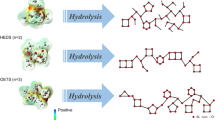Abstract
Hydroxyakyl terminated silanes were prepared by reacting 3-aminopropyl alkoxysilanes with ethylene carbonate. Unlike most silanes, these hydrophilic silanes are partially hydrolyzed in water and the siloxane oligomers thus obtained remain soluble in the water. Further condensation leads to water soluble linear or branched polysiloxanes depending on the structure of the hydroxylalkyl terminated silane. The water solubility is not limited to a narrow pH range and does not require alcohols (or other additives). The preparation method of these silanes was found to proceed smoothly at RT with no need for a solvent or a catalyst. The reactions followed second order reaction kinetics irrespective of the number of alkoxy groups attached to the silicon atom. Some condensation was unavoidable even in the absence of any catalyst but the viscosity remained low (0.10–0.16 Pa·sec) and was primarily dependent on the density of branching and the extent of the hydrogen bonding. The structures of these silanes were confirmed by FTIR, 1H NMR and 29Si NMR.
Similar content being viewed by others
References
Arkles B (2006) Hydrophobicity, hydrophilicity and silane surface modification. Gelest, Inc. Available via www.gelest.com. http://www.gelest.com/goods/pdf/Hydrophobicity.pdf.
Arkles B (1994) Hydroxymethyltrialkoxysilanes and methods of making and using the same. United States Patent 5371262, 12/06/1994
Kihara N, Kushida Y, Endo T (1996) Optically active poly(hydroxyurethane)s derived from cyclic carbonate and L-lysine derivatives. J Polym Sci Pol Chem 34(11):2173–2179
Tomita H, Sanda F, Endo T (2001) Structural analysis of polyhydroxyurethane obtained by polyaddition of bifunctional five-membered cyclic carbonate and diamine based on the model reaction. J Polym Sci Pol Chem 39(6):851–859
Pease AC, Solas D, Sullivan EJ, Cronin MT, Holmes CP, Fodor SPA (1994) Light-generated oligonucleotide arrays for rapid DNA-sequence analysis. Proc Natl Acad Sci USA 91(11):5022–5026
Graiver D (2009) Rearranging hyperbranched silyl ether polymers silicon-containing dendritic polymers. In: Dvornic PR, Owen MJ (eds) Advances in silicon science, vol 2. Springer Netherlands, pp 377–389. doi:10.1007/978-1-4020-8174-3_14
Anderson AG (1999) Preparation of hydroxy urethanes. United States Patent 5977262, 11/02/1999
David MJ (1953) Hydroxy carbamates and process of producing same. United States Patent 2627524, 02/03/1953
Coury AJ, Hobot CM (1989) Hydroxyl functional monomers. United States Patent 4883854, 11/28/1989
Angeles E, Santillan A, Martinez I, Ramirez A, Moreno E, Salmon M, Martinez R (1994) A Simple method for the synthesis of carbamates. Synthetic Commun 24(17):2441–2447
Henkelmann J, Ruhl T (1998) Process for the preparation of 1,3-disubstituted imidazolidinones. United States Patent 5783706, 07/21/1998
Tomita H, Sanda F, Endo T (2001) Reactivity comparison of five- and six-membered cyclic carbonates with amines: basic evaluation for synthesis of poly(hydroxyurethane). J Polym Sci Pol Chem 39(1):162–168
Shi X, Graiver D, Narayan R (2012) Hydrolysis and condensation of hydrophilic alkoxysilanes under acidic conditions. Silicon :1–11. doi:10.1007/s12633-012-9108-0
Author information
Authors and Affiliations
Corresponding author
Rights and permissions
About this article
Cite this article
Tachibana, Y., Shi, X., Graiver, D. et al. Hydroxyl Terminated Hydrophilic Silanes. Silicon 4, 167–174 (2012). https://doi.org/10.1007/s12633-012-9118-y
Received:
Accepted:
Published:
Issue Date:
DOI: https://doi.org/10.1007/s12633-012-9118-y




